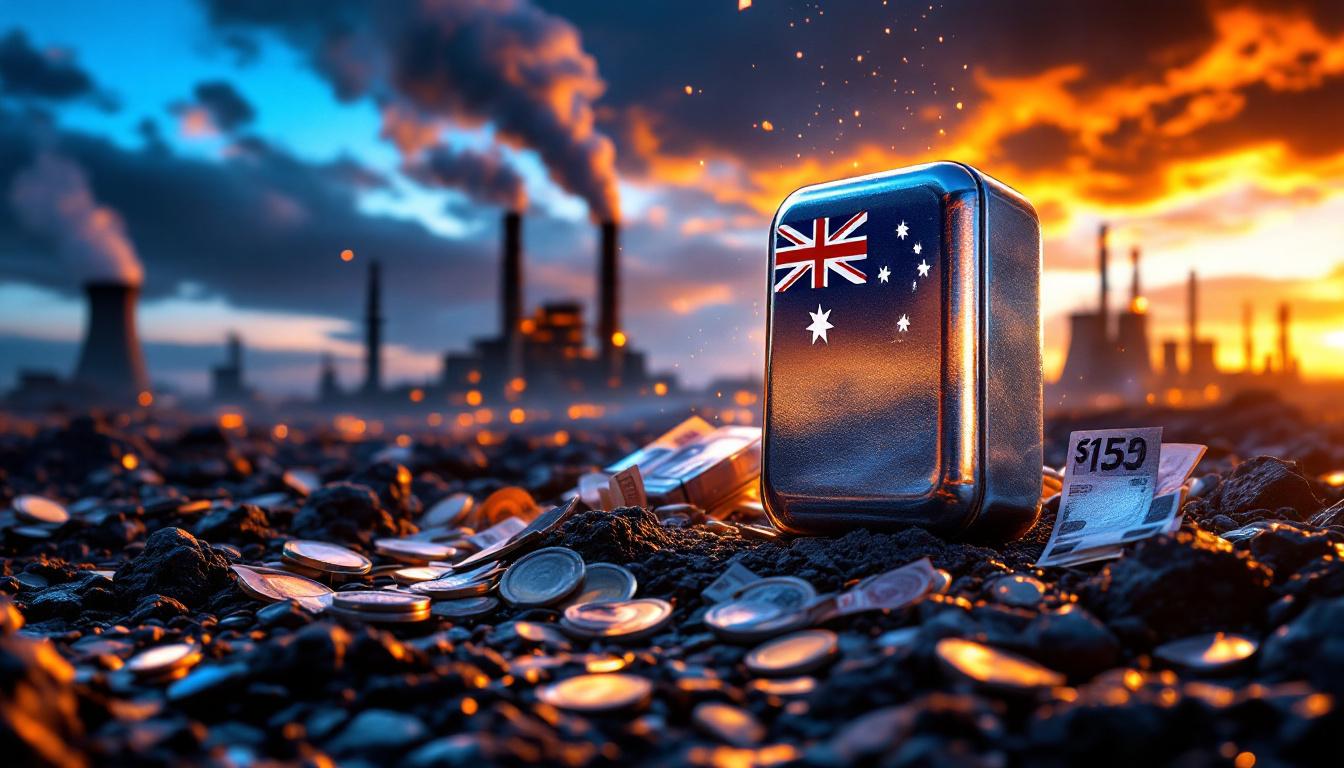How Did the Recent Australian Election Impact Energy Policy?
The recent Australian federal election delivered an unexpected outcome, with the Labor Party securing another term in government despite achieving the lowest primary vote in their history at just 34%. This result has significant implications for Australia's energy landscape, particularly regarding nuclear energy, renewable development, and critical minerals transition.
The election campaign saw nuclear energy emerge as a key battleground, with the Liberal-National Coalition advocating for nuclear power while Labor maintained its anti-nuclear stance. Interestingly, for the first time in Australian electoral history, the traditional "nuclear nimby" (not in my backyard) scare campaign failed to gain traction, with electorates where nuclear plants were proposed showing steady support for the policy.
The Winning Strategy: Cost Concerns Over Nuclear Implementation
Labor's successful campaign strategy pivoted away from environmental fears about nuclear power and instead focused on economic arguments. They leveraged a figure of $600 billion—originally cited by a renewable industry group—as the potential cost of implementing nuclear energy in Australia. This was paired with claims that such expenditure would necessitate cuts to Medicare (Australia's public healthcare system).
This economic framing proved highly effective, causing public support for nuclear energy to decline sharply during the campaign period. As one industry expert noted, "It was a complete lie, but it was wildly successful." The outcome has reinforced Labor's commitment to renewable energy pathways while sidelining nuclear development for at least another term.
While the $600 billion figure has been widely contested by nuclear advocates as grossly inflated, the economic messaging resonated with voters concerned about rising living costs, demonstrating how financial arguments often triumph over environmental or technical considerations in energy debates.
What Does Labor's Victory Mean for Australia's Energy Future?
With Labor securing a majority government, Energy Minister Chris Bowen has interpreted the election result as a mandate to accelerate his renewable energy agenda. This represents both a continuation of existing policies and potentially an intensification of renewable targets.
"Bowen is doubling down," according to industry observers. "He's viewing this as validation of the renewable-focused pathway despite the historically low primary vote for Labor."
Avoiding a More Radical Scenario
Many analysts suggest that despite disappointment from those hoping for a change in government, the outcome could have been more disruptive to energy markets. A minority Labor government dependent on Greens support—which many had predicted—would likely have implemented more radical climate policies with potentially greater economic impacts.
The stability of a majority government allows for more measured implementation of energy policies, providing some certainty for investors even if the direction remains contentious.
The Greens' Diminished Influence
Notably, the Greens suffered significant electoral losses, including the defeat of their leader Adam Bandt in what was previously considered a safe seat. Political commentators attribute this to the party's shift away from core environmental issues toward broader social justice causes, which apparently failed to resonate with voters.
"The Greens went woke, and voters didn't follow," observed one analyst. This reduced Green presence in parliament may actually moderate some of the more ambitious climate policy proposals that might have gained traction with a stronger Greens contingent.
How Are Rising Energy Costs Affecting Australia?
A concerning development for Australian consumers emerged shortly after the election when the Australian Energy Regulator approved electricity price increases of up to 10% for the current year. These increases are primarily attributed to the costs of transmission infrastructure expansion needed to support the growing renewable energy sector.
"The timing of this approval—immediately following the election—has raised eyebrows," noted industry observers. "Many believe these increases were deliberately held back until after votes were cast."
The Hidden Costs of the Energy Transition
This price hike highlights one of the challenges in Australia's renewable-focused energy transition: while generation costs may be competitive, the associated transmission infrastructure represents a significant additional expense that is ultimately passed on to consumers. Critics argue these costs were downplayed during the election campaign, only to be announced after votes were cast.
"Transmission in Australia has a very good track record of being over budget," explained one energy expert. This creates a substantial challenge for affordability as Australia pursues its renewable targets.
The regulatory approval process for these price increases has raised questions about transparency, with some suggesting the timing—coming just after the election—was politically motivated to avoid electoral backlash.
What's Happening with Australia's Major Energy Projects?
Despite Labor's climate commitments and renewable energy focus, the government has made pragmatic decisions regarding fossil fuel projects that demonstrate the complex balancing act between environmental goals and economic realities.
Karatha Gas Plant Extension
In a move that has angered environmental groups, the federal government recently approved a 50-year extension for the Karatha gas plant—reportedly the largest carbon dioxide emitter in the Southern Hemisphere. This decision, delayed until after the election, highlights the tension between Australian politics and energy policy commitments and Australia's economic reliance on resource exports.
The approval sends a signal that despite its climate rhetoric, the Labor government recognizes the continued importance of traditional energy sources to Australia's economy and export markets. It also aims to reassure international investors about sovereign risk in Australia's resource sector.
Green Hydrogen Setbacks
Australia's ambitious green hydrogen plans have faced significant challenges, with multiple federally funded projects reportedly folding. This creates a substantial planning problem for Australia's energy grid, as regulators had assumed approximately 14 gigawatts of renewable-powered hydrogen electrolyzers would be available to balance the system by absorbing excess renewable energy.
"Most of the green hydrogen projects that have been funded by federal grants have all folded," noted one industry insider. This reality check highlights the gap between ambitious policy announcements and practical implementation challenges.
With these projects failing to materialize, grid planners must reconsider how to provide balance and storage in a renewable-heavy system. This represents a significant gap in Australia's energy transition planning that will require new solutions.
How Is Australia Approaching Household Energy Storage?
A key component of Australia's renewable energy strategy involves widespread adoption of household batteries, but implementation faces significant economic hurdles.
Ambitious Assumptions vs. Economic Reality
Australia's energy network planners have made the remarkable assumption that 95% of households will install battery storage by 2050, providing approximately 160 gigawatt-hours of storage that the network can access. This assumption helps make "firmed renewables" appear more cost-effective in planning documents, as the capital costs are borne by homeowners rather than included in network infrastructure costs.
However, the economic case for household batteries remains challenging. With payback periods of 7-8 years—often coinciding with the end of warranty periods—many consumers see limited financial incentive to invest. As one analyst put it: "The typical homeowner is asking, 'Why am I doing this? I'm not saving any money.'"
The government has responded with subsidies covering approximately 50% of battery costs, but critics argue these subsidies should be counted in the overall cost of the renewable transition rather than treated separately.
The Need for Transparent Cost Analysis
A recurring theme in Australia's energy debate is the call for comprehensive, whole-system cost analysis of different energy pathways. Critics argue that current approaches artificially separate costs (like subsidies for rooftop solar and batteries) from the renewable energy system, creating a misleading picture of relative costs between different energy options.
By treating household expenditure as "behind the meter" and therefore excluded from system costs, planners may be underestimating the true economic impact of the renewable transition on Australian consumers and the broader economy.
What's the Status of Nuclear and Uranium in Australia?
Despite the election outcome maintaining Australia's anti-nuclear energy stance, there are developments in the uranium mining update sector that could position Australia as a significant global supplier.
Policy Constraints on a Competitive Industry
Australia possesses substantial uranium resources that could be economically extracted, particularly through in-situ recovery (ISR) mining methods. However, state-level bans in Western Australia and Queensland—Australia's resource-rich states—prevent new uranium mines from being developed.
In-situ recovery mining, which uses dissolved oxygen injected into sandstone aquifers to mobilize uranium with minimal surface disturbance, offers cost-competitive extraction opportunities in Australia that remain untapped due to political constraints.
Interestingly, these bans now cross political lines, with Labor-governed Western Australia and Liberal-governed Queensland both maintaining restrictions. This suggests the issue has moved beyond partisan politics to one requiring practical reconsideration.
International Uranium Market Developments
The global uranium market dynamics are seeing increased activity, with the World Nuclear Fuel conference being held in Sydney for the first time in approximately 50 years—a deliberate choice to highlight Australia's potential as a future uranium supplier.
Recent developments in the uranium investment sector, including a premium placement by Sprott Physical Uranium Trust, suggest growing market confidence. However, industry participants note that while sentiment is improving, uranium prices still need to rise significantly to incentivize new production.
"We're seeing uranium around $85 per pound," noted one market observer, "but the incentive price for new production is closer to $100." This price dynamic will be crucial for determining how quickly Australia's uranium sector can expand, even if policy barriers are removed.
How Do Recent US Nuclear Policies Affect Australia?
Recent executive orders from the United States aiming to quadruple nuclear energy production and streamline regulatory processes have global implications, including for Australia.
Contrasting Approaches to Nuclear Energy
The stark contrast between US uranium policy and Australian approaches to nuclear energy highlights Australia's increasingly isolated position. While the US is expediting approvals for nuclear projects—in some cases reducing timeframes from years to weeks—Australia maintains prohibitive policies despite possessing significant uranium resources and technical capabilities.
"Companies like Anfield Energy have received approvals in less than two weeks," noted one industry observer, contrasting this with Australia's multi-year approval processes even for conventional resources.
This divergence raises questions about Australia's future competitiveness in a world where nuclear energy is increasingly recognized as a critical component of decarbonization strategies.
The Challenge of Messaging
The reception of US nuclear policy in Australia demonstrates how political framing can influence energy discussions. Rather than focusing on the bipartisan nature of US nuclear support (with both major US parties supporting nuclear expansion), Australian commentary has often characterized these policies in partisan terms, potentially undermining their consideration in the Australian context.
This represents a missed opportunity for more balanced policy discussion that acknowledges international trends toward nuclear inclusion in low-carbon energy systems.
What Are the Challenges for Australia's Energy Future?
Australia faces several critical challenges in implementing its energy transition strategy:
Technical Implementation Gaps
The failure of green hydrogen projects highlights a gap between ambitious plans and practical implementation. Similarly, the economic barriers to household battery adoption suggest that key assumptions in Australia's energy planning may not materialize as expected.
These implementation challenges require careful reconsideration of network planning assumptions and potentially more conservative approaches to ensure system reliability.
Transparency in Cost Analysis
A recurring theme is the need for transparent, whole-system cost analysis of different energy pathways. Current approaches that separate subsidies, behind-the-meter investments, and network costs may create a misleading picture of the relative economics of different options.
As one analyst noted: "If we're going to have a rational debate about energy futures, we need to put all costs on the table—not hide them in different budgets or behind consumer walls."
Political Polarization
Energy policy remains highly politicized in Australia, with partisan framing often overshadowing technical and economic considerations. This polarization makes it difficult to develop consistent, long-term energy strategies that can survive electoral cycles.
The contrast with more bipartisan approaches in countries like the United States is striking and potentially disadvantages Australia in developing stable, investor-friendly energy policies.
Global Competitiveness Concerns
As other nations embrace diverse energy strategies, including nuclear, Australia's more restricted approach may affect its long-term economic competitiveness, particularly in energy-intensive industries.
The risk of higher electricity costs and less reliable supply could drive manufacturing and processing industries offshore, representing a significant economic challenge for Australia critical minerals future.
How Might Australia's Energy Policy Evolve?
Despite the current policy direction, several factors could drive evolution in Australia's energy approach:
Economic Reality Check
Rising energy prices and implementation challenges with the current renewable-focused strategy may force reconsideration of policy settings. The 10% electricity price increase already approved this year could be just the beginning of consumer pressure on policymakers.
As these costs become more visible to consumers and businesses, political pressure for alternative approaches may grow, potentially creating openings for policy evolution.
International Influence
As major economies like the United States accelerate nuclear development and other low-carbon technologies, Australia may find itself under increasing pressure to reconsider its position, particularly if economic competitiveness concerns grow.
The global trend toward technology-neutral approaches to decarbonization may eventually influence Australian politics and energy policy, especially if economic disadvantages become more apparent.
State-Level Innovation
While federal policy remains committed to renewables, individual states may take different approaches. South Australia's Premier Peter Malinauskas, for example, combines support for renewables with openness to uranium mining and nuclear energy—potentially providing a model for a more pragmatic approach.
"Malinauskas represents a new generation of Labor politicians who are less ideological and more practical," observed one analyst. This state-level pragmatism could eventually influence federal approaches.
Electoral Dynamics
Although Labor secured a majority in this election, Australia has a history of dramatic electoral swings. The historically low 34% primary vote for Labor suggests potential vulnerability in future elections if energy costs continue to rise or implementation challenges mount.
Future electoral cycles may create opportunities for policy reconsideration, particularly if energy affordability becomes a more prominent voter concern.
What Can We Learn from Australia's Energy Policy Experience?
Australia's experience offers several lessons for energy transitions globally:
The Importance of Economic Messaging
The election outcome demonstrates that economic arguments often trump environmental concerns in energy debates. Labor's successful focus on cost rather than safety concerns around nuclear energy proved decisive.
This suggests that advocates for any energy technology need to focus on economic benefits rather than technical merits or environmental attributes to gain political traction.
The Challenge of System Integration
Australia's challenges with integrating high levels of renewable energy highlight the importance of whole-system planning. Assumptions about complementary technologies (like green hydrogen) need careful testing before being built into critical infrastructure plans.
The failure of green hydrogen projects and questions about battery adoption demonstrate the risks of planning based on optimistic technology deployment scenarios.
The Risk of Policy Discontinuity
Australia's frequent policy shifts with changing governments create investment uncertainty. Countries that maintain more consistent energy policies across electoral cycles may achieve more efficient transitions.
The contrast with more stable policy environments in countries like France or South Korea highlights the economic cost of Australia's energy policy volatility.
The Value of Diverse Options
Australia's experience suggests that prematurely excluding energy options (like nuclear) can create vulnerabilities and potentially higher costs in energy transitions. Maintaining technological flexibility may prove valuable as decarbonization challenges intensify.
As one observer noted: "The countries making the most progress on decarbonization are those keeping all low-carbon options on the table, not picking winners based on ideology."
FAQs About Australian Energy Policy
Why is Australia resistant to nuclear energy despite its uranium resources?
Australia's anti-nuclear stance stems from historical environmental movements, public concerns about safety, and the country's abundant coal and renewable resources. The policy has become entrenched across multiple governments despite Australia being one of the world's largest uranium exporters.
How does Australia plan to balance its grid with high renewable penetration?
Australia's current plans rely heavily on transmission expansion, pumped hydro storage, battery deployment (both utility and household scale), and originally anticipated green hydrogen production. With some of these components facing challenges, the balancing strategy may require revision.
Will rising energy costs change Australia's renewable energy trajectory?
While the government remains committed to its renewable energy targets, continued price increases could create political pressure for policy adjustments. The 10% increase approved shortly after the election has already generated significant public discussion about energy affordability.
How do Australia's energy policies compare internationally?
Australia's approach features stronger resistance to nuclear energy than many comparable nations, including the UK, US, France, and increasingly Asian economies like Japan and South Korea. Its renewable ambitions are relatively aggressive, but implementation challenges are highlighting the complexity of high-renewable systems.
Could Australia's uranium mining industry expand despite domestic nuclear restrictions?
Yes, there's growing pressure to lift state-level bans on uranium mining in Western Australia and Queensland, which would allow Australia to expand its role as a global uranium supplier even while maintaining restrictions on domestic nuclear energy development.
Searching for ASX Mineral Discovery Opportunities?
Stay ahead of the market with real-time alerts on significant mineral discoveries from Discovery Alert's proprietary Discovery IQ model, transforming complex ASX announcements into actionable investment insights. Explore how major mineral discoveries have generated substantial returns by visiting our dedicated discoveries page and begin your 30-day free trial today.




